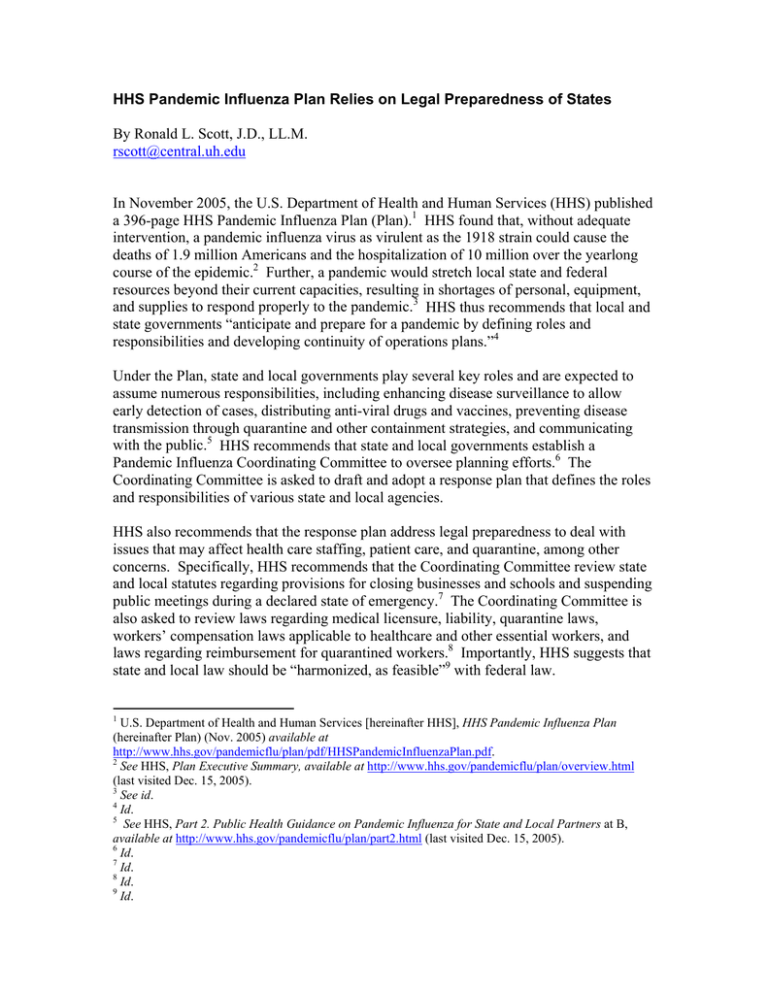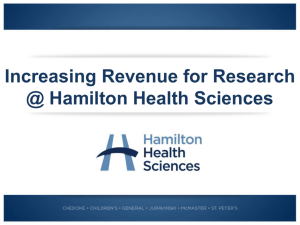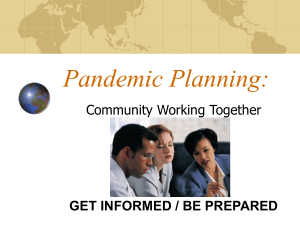HHS Pandemic Influenza Plan Relies on Legal Preparedness of States
advertisement

HHS Pandemic Influenza Plan Relies on Legal Preparedness of States By Ronald L. Scott, J.D., LL.M. rscott@central.uh.edu In November 2005, the U.S. Department of Health and Human Services (HHS) published a 396-page HHS Pandemic Influenza Plan (Plan).1 HHS found that, without adequate intervention, a pandemic influenza virus as virulent as the 1918 strain could cause the deaths of 1.9 million Americans and the hospitalization of 10 million over the yearlong course of the epidemic.2 Further, a pandemic would stretch local state and federal resources beyond their current capacities, resulting in shortages of personal, equipment, and supplies to respond properly to the pandemic.3 HHS thus recommends that local and state governments “anticipate and prepare for a pandemic by defining roles and responsibilities and developing continuity of operations plans.”4 Under the Plan, state and local governments play several key roles and are expected to assume numerous responsibilities, including enhancing disease surveillance to allow early detection of cases, distributing anti-viral drugs and vaccines, preventing disease transmission through quarantine and other containment strategies, and communicating with the public.5 HHS recommends that state and local governments establish a Pandemic Influenza Coordinating Committee to oversee planning efforts.6 The Coordinating Committee is asked to draft and adopt a response plan that defines the roles and responsibilities of various state and local agencies. HHS also recommends that the response plan address legal preparedness to deal with issues that may affect health care staffing, patient care, and quarantine, among other concerns. Specifically, HHS recommends that the Coordinating Committee review state and local statutes regarding provisions for closing businesses and schools and suspending public meetings during a declared state of emergency.7 The Coordinating Committee is also asked to review laws regarding medical licensure, liability, quarantine laws, workers’ compensation laws applicable to healthcare and other essential workers, and laws regarding reimbursement for quarantined workers.8 Importantly, HHS suggests that state and local law should be “harmonized, as feasible”9 with federal law. 1 U.S. Department of Health and Human Services [hereinafter HHS], HHS Pandemic Influenza Plan (hereinafter Plan) (Nov. 2005) available at http://www.hhs.gov/pandemicflu/plan/pdf/HHSPandemicInfluenzaPlan.pdf. 2 See HHS, Plan Executive Summary, available at http://www.hhs.gov/pandemicflu/plan/overview.html (last visited Dec. 15, 2005). 3 See id. 4 Id. 5 See HHS, Part 2. Public Health Guidance on Pandemic Influenza for State and Local Partners at B, available at http://www.hhs.gov/pandemicflu/plan/part2.html (last visited Dec. 15, 2005). 6 Id. 7 Id. 8 Id. 9 Id. Concepts of federalism make such harmonization an elusive goal at best. For example, a key component of the Plan is effective containment of a virus, yet HHS recognizes the limited federal role in containment efforts, noting: “States, localities, and tribes have primary responsibility for public health matters within their borders, including isolation and quarantine. Current quarantine laws, regulations, and enforcement procedures vary widely from state to state. Many of these laws date to the 19th century.”10 Although the federal government plays an important role in protecting public health, the “police powers” of the states are key to enforcing quarantine/isolation efforts, mandating vaccination, and mandating reporting of infectious diseases. The U.S. Supreme Court in Jacobson v. Massachusetts established the constitutionality of state powers over public health.11 In Jacobson, a board of health ordered that all inhabitants of a city be vaccinated for smallpox.12 The Court upheld the compulsory vaccination and said that “the police power of a state must be held to embrace, at least, such reasonable regulations . . . as will protect the public health and the public safety.”13 As HHS noted, current quarantine laws vary significantly from state to state. The threat of bioterrorism prompted the Centers for Disease Control and Prevention (CDC) to draft the Model State Emergency Health Powers Act (MSEHPA).14 The MSEHPA is intended to assist state governments in developing effective emergency health powers laws. Under the MSEPHA, a state may “use every available means to prevent the transmission of infectious disease and to ensure that all cases of contagious disease are subject to proper control and treatment.”15 During a declared public health emergency, a public health authority under the MSEPHA may perform physical examinations or tests as necessary for the diagnosis or treatment of individuals and may isolate or quarantine a person who refuses such examination or testing.16 The public health authority may also vaccinate persons to protect against infectious disease and to prevent the spread of disease, may treat persons exposed to or infected with disease, and may isolate or quarantine persons who are unable or unwilling to undergo vaccination or treatment.17 The MSEHPA also grants the public health authority broad powers to isolate or quarantine individuals or groups of individuals.18 As of June 30, 2005, the MSEHPA has been introduced in whole or part in 44 states, and 37 states have passed laws that include provisions from or similar to those in the 10 See HHS, Plan Supplement 8: Community Disease Control and Prevention, available at http://www.hhs.gov/pandemicflu/plan/pdf/S08.pdf (last visited Dec. 15, 2005). 11 Jacobson v. Commonwealth of Massachusetts, 197 U.S. 11 (1905). 12 Id. at 12-13. 13 Id. at 25. 14 Johns Hopkins University Bloomberg School of Public Health, Center for Law and the Public’s Health [hereinafter Center for Law and the Public’s Health], Draft Model State Emergency Health Powers Act [hereinafter MSEHPA] (Dec. 21, 2001), available at http://www.publichealthlaw.net/MSEHPA/MSEHPA2.pdf. 15 Id. § 601. 16 Id. § 602. 17 Id. § 603. 18 Id. § 604. 2 MSEHPA.19 However, “the extent to which the [MSEHPA] provisions were incorporated into each state’s laws varies.”20 Other “model acts” have also been proposed.21 States may be directly burdened economically under the Plan. The federal government will provide “$100 million to update state pandemic plans, but also [will] require[] states to spend about $510 million of their own money to buy enough Tamiflu for 31 million people to supplement the federal stockpile.”22 Therefore, availability of the anti-viral drug may depend on where one lives because “some states may not be able to [afford] the drug.”23 One thing is clear. Success of the HHS Plan depends heavily on how well state and local authorities respond to the responsibilities placed on them in the Plan, particularly their legal preparedness. December 2005 19 See Center for Law and the Public’s Health, Model State Public Health Laws, available at http://www.publichealthlaw.net/Resources/Modellaws.htm#MSEHPA (last visited Dec. 15, 2005). 20 Id. 21 Id. 22 Lauran Neergaard, Associated Press, States On Flu-Fight Front Lines, (Nov. 3, 2005) available at http://seattlepi.nwsource.com/health/246925_birdflu03.html?source=rss. 23 Id. 3


